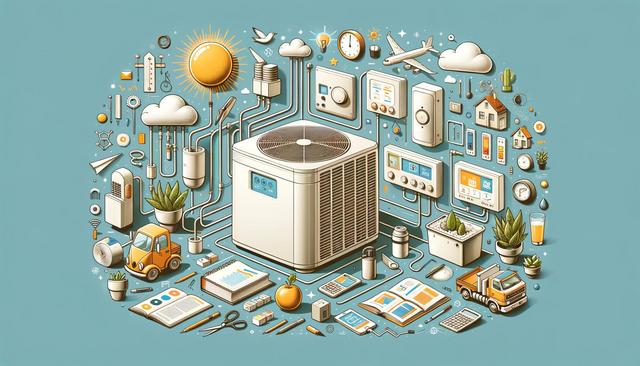Understanding the Role of Smart HVAC Monitoring Systems
Smart HVAC monitoring systems are transforming how residential and commercial buildings manage indoor climate. These systems provide detailed insights into the health and performance of heating, ventilation, and air conditioning equipment. By integrating advanced technologies such as the iot based hvac control system and hvac monitoring software, users can track environmental conditions and system performance in real time. The core benefit is the ability to optimize comfort while reducing energy usage and operational costs. A smart hvac monitoring system doesn’t just automate temperature control—it ensures that the entire HVAC setup runs efficiently by using data-driven decisions.
Key components in these systems include hvac monitoring sensors, control boards, and cloud-based platforms. These elements work together to regulate airflow, temperature, and humidity levels. In homes, a residential hvac monitoring system can help detect issues early and notify homeowners of needed maintenance. In commercial settings, the same technology scales to manage multiple zones and units, offering centralized control and reporting capabilities.
IoT Integration and Real-Time Monitoring
The advancement of the Internet of Things (IoT) has led to the development of the iot hvac monitoring system, which allows HVAC devices to communicate through the internet. This connectivity empowers building managers and homeowners to monitor and control systems remotely via smartphones or desktop platforms. HVAC monitoring equipment now includes sensors that relay data to cloud servers, where it’s analyzed to detect anomalies and optimize performance. This continuous connectivity also supports predictive maintenance by identifying patterns and suggesting service before problems escalate.
Some of the primary advantages of IoT-enabled HVAC systems include:
- Remote accessibility from virtually any location
- Automated alerts for filter changes, leaks, or irregular system behavior
- Integration with smart home or building management systems
- Real-time data visualization for better decision-making
By leveraging an iot based hvac control system, users gain a higher degree of control over their indoor environments, resulting in improved energy savings and system longevity.
The Importance of HVAC Monitoring Sensors and Equipment
At the heart of any effective HVAC monitoring system are the hvac monitoring sensors. These sensors track key indicators such as temperature, humidity, pressure, and airflow. When connected to an hvac control board, the data is processed and used to adjust operations dynamically. For example, if a sensor detects that a room is too warm, the system can automatically adjust the cooling output or open vents via hvac vent control mechanisms.
Advanced hvac monitoring equipment often includes:
- Temperature and humidity sensors for climate accuracy
- Air quality sensors for detecting pollutants
- Energy meters to evaluate system efficiency
- Vibration sensors to monitor mechanical wear and tear
These tools collectively enhance the reliability of HVAC systems. Maintenance teams can use the data to schedule services more effectively, reducing downtime and unexpected costs.
Efficient HVAC Vent Control and Zone Management
One of the most impactful features of a smart hvac monitoring system is its ability to manage different zones within a building. Through precise hvac vent control, airflow can be directed where it’s needed most, improving comfort and reducing energy waste. In residential settings, this means adjusting vents in bedrooms at night while reducing airflow in unoccupied areas. In commercial buildings, it allows for tailored climate settings across offices, meeting rooms, and common areas.
Zone management is especially beneficial for:
- Multi-story homes or buildings with varying heating/cooling needs
- Spaces with large windows or unique architectural features
- Buildings with mixed-use areas such as kitchens, offices, and lounges
By using hvac monitoring software, users can define schedules, set preferences, and monitor changes over time. This level of customization not only enhances comfort but also contributes to long-term energy savings.
Choosing and Implementing the Right Monitoring System
Selecting the appropriate hvac monitoring system depends on the building size, layout, and existing infrastructure. For homes, a residential hvac monitoring system might include basic sensors and app-based controls. Commercial setups, on the other hand, may require a more robust network of devices and analytics platforms. Regardless of the scale, ensuring compatibility with existing hvac control board configurations is essential for seamless integration.
Steps to consider when implementing a new system:
- Assess current HVAC infrastructure and control needs
- Choose hvac monitoring equipment that aligns with your operational goals
- Ensure the system includes hvac monitoring software for data analysis
- Set up user access and remote control features
- Train personnel or household members on system use
Proper planning and installation help maximize the value of the system, providing consistent performance monitoring and control over time.
Conclusion: Enhancing Comfort and Efficiency with Smart HVAC Monitoring
For homeowners and facility managers alike, integrating a smart HVAC monitoring system offers a practical path to improved comfort, cost savings, and energy efficiency. By using tools such as hvac monitoring sensors, iot based hvac control systems, and intelligent hvac vent control, users can maintain optimal indoor environments with minimal manual effort. Whether it’s a residential hvac monitoring system or a more complex commercial setup, the ability to monitor, adjust, and optimize HVAC performance remotely is a valuable asset in modern building management.




Leave a Reply